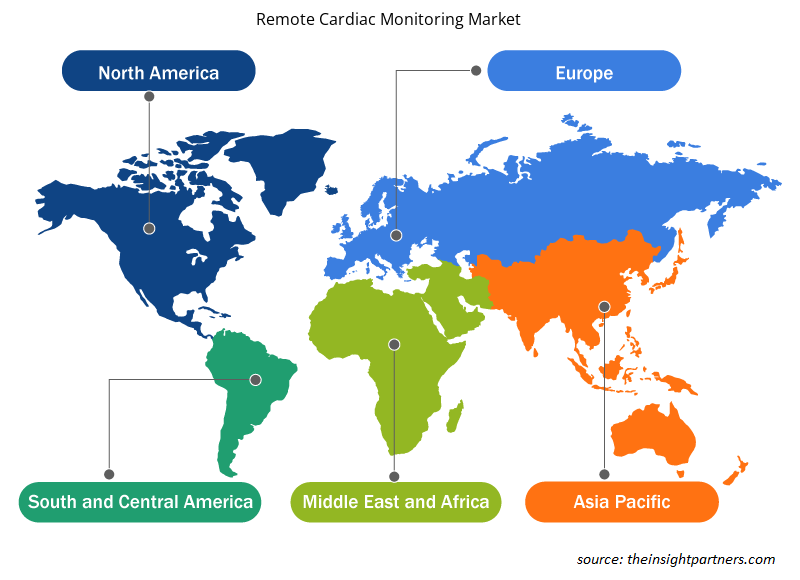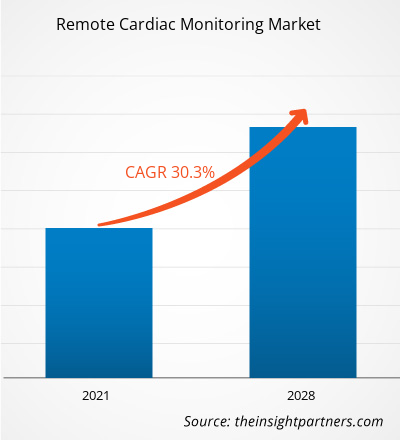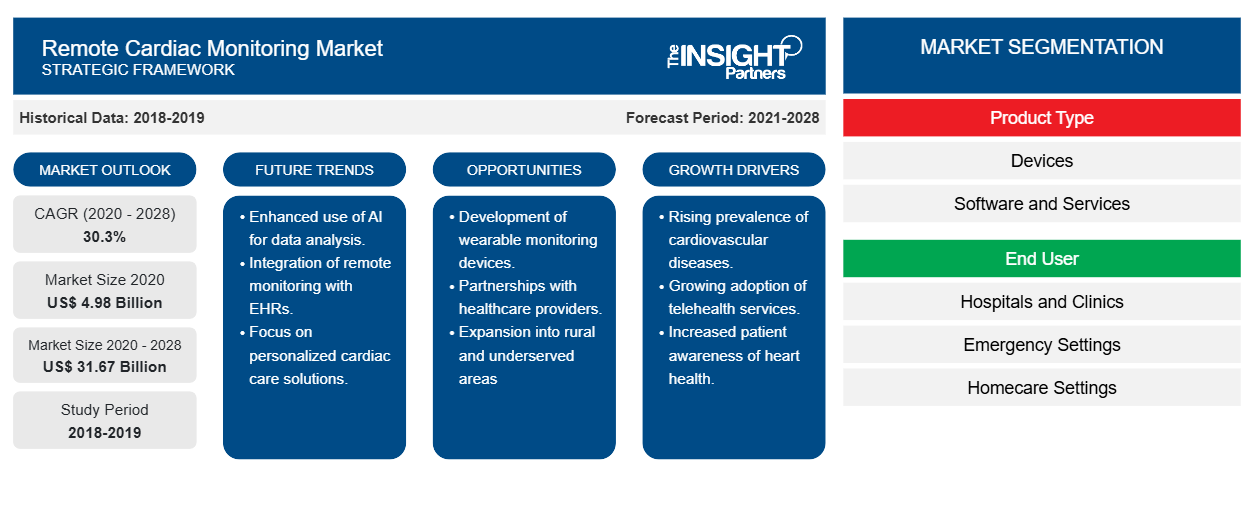Se proyecta que el mercado de monitoreo cardíaco remoto alcance los US$ 31.671,69 millones para 2028 desde los US$ 4.976,40 millones en 2021; se estima que crecerá a una CAGR del 30,3% entre 2021 y 2028.
Los dispositivos de monitorización cardíaca a distancia permiten una monitorización continua de las actividades eléctricas del corazón fuera de los hospitales. También permiten la monitorización electrocardiográfica (ECG) en el hogar de pacientes con sospecha de arritmias cardíacas o en riesgo de desarrollar arritmias. La monitorización también se puede realizar cuando los pacientes están inmersos en sus actividades diarias. Por tanto, uno de los beneficios más importantes de la monitorización cardíaca a distancia con dispositivos es que disminuye la necesidad de visitas médicas de rutina. Dispositivos como marcapasos y desfibriladores cardioversores implantables se implantan en el corazón de los pacientes mediante procedimientos mínimamente invasivos. Un transmisor que funciona en sincronía con el dispositivo se encarga de la transmisión de datos. Factores como el aumento de la incidencia de enfermedades cardiovasculares (ECV) y los continuos avances en el enfoque de la telemedicina impulsan el crecimiento del mercado de la monitorización cardíaca a distancia . Sin embargo, las preocupaciones sobre la privacidad de los datos obstaculizan el crecimiento del mercado.
Personalice este informe según sus necesidades
Obtendrá personalización en cualquier informe, sin cargo, incluidas partes de este informe o análisis a nivel de país, paquete de datos de Excel, así como también grandes ofertas y descuentos para empresas emergentes y universidades.
-
Obtenga las principales tendencias clave del mercado de este informe.Esta muestra GRATUITA incluirá análisis de datos, desde tendencias del mercado hasta estimaciones y pronósticos.
Perspectivas del mercado
Aumento de la incidencia de enfermedades cardiovasculares
La monitorización remota de pacientes (RPM) permite a los pacientes gestionar mejor su salud al aumentar su participación en su atención médica. La Asociación Estadounidense del Corazón apoya iniciativas para incentivar el diseño y el uso de tecnologías de monitorización remota de pacientes basadas en evidencia. Según la Organización Mundial de la Salud (OMS), las enfermedades cardiovasculares (ECV) se encuentran entre las principales causas de muerte en todo el mundo, y aproximadamente 30 millones de personas sufren un accidente cerebrovascular cada año. Según la Asociación Estadounidense del Corazón, casi la mitad de todos los adultos en los EE. UU. tienen un tipo de ECV. Además, se proyecta que más de 130 millones de personas, es decir, el 45,1% de la población de EE. UU., tendrán un tipo de ECV para 2035. Según informes de la Sociedad Europea de Cardiología, las ECV causan 3,9 millones de muertes en Europa y más de 1,8 millones de muertes en la Unión Europea (UE). Además, representan el 45% de todas las muertes en Europa y el 37% del total de muertes en la UE. En los países de Asia y el Pacífico, la mortalidad por ECV oscila entre menos del 20% en países como Tailandia, Filipinas e Indonesia y entre el 20% y el 30% en las zonas urbanas de China, Hong Kong, Japón, Corea y Malasia. Además, Nueva Zelanda, Australia y Singapur, entre otros, tienen tasas relativamente altas, del 30% al 35%.
La hipertensión es un factor de riesgo importante para las ECV. La prevalencia ajustada por edad de la hipertensión entre los adultos en los EE. UU. es de ~35%, lo que equivale a una población de ~85 millones. Para 2035, ~42% de los adultos del país, es decir, 27 millones adicionales, tendrán esta condición. La carga de costos de la hipertensión en las economías también está aumentando, y es probable que los costos se disparen de ~US$ 70 mil millones en 2015 a ~US$ 150 mil millones para 2035. La monitorización remota de pacientes puede servir como un conducto vital para mejorar el control de la hipertensión y reducir la carga económica derivada de las estancias hospitalarias prolongadas o frecuentes que resultan de eventos relacionados con la hipertensión aguda. La investigación ha demostrado que la monitorización remota de pacientes (RPM) puede reducir significativamente la presión arterial sistólica (PAS) y la presión arterial diastólica (PAD) en comparación con la atención habitual y la automonitorización por sí sola. Según algunos ensayos no aleatorizados, los dispositivos de RPM pueden mejorar los resultados al permitir una detección temprana y precisa, así como reducir las tasas de mortalidad por todas las causas y las hospitalizaciones. Las guías clínicas recientes recomiendan enfáticamente el uso de RPM para la detección de fibrilación auricular (FA) tanto en pacientes con ACV como en pacientes sin ACV.
Información basada en el tipo de producto
Según el tipo de producto, el mercado de monitorización cardíaca remota se segmenta en dispositivos, software y servicios. El segmento de dispositivos tuvo una mayor participación de mercado en 2021 y se espera que registre una CAGR más alta durante el período de pronóstico.
Información basada en el usuario final
Según el usuario final, el mercado de monitorización cardíaca remota se segmenta en hospitales y clínicas, entornos de emergencia, entornos de atención domiciliaria y otros. El segmento de hospitales y clínicas tendría la mayor participación de mercado en 2021, mientras que se espera que el mercado del segmento de entornos de emergencia crezca a una CAGR del 31,60 % durante el período de pronóstico.
Varias empresas que operan en el mercado de monitoreo cardíaco remoto están adoptando estrategias como lanzamientos de productos, fusiones y adquisiciones, colaboraciones, innovaciones de productos y expansiones de carteras de productos para expandir su presencia en todo el mundo, mantener la marca y satisfacer la creciente demanda de los usuarios finales.
Perspectivas regionales del mercado de monitorización cardíaca remota
Los analistas de Insight Partners explicaron en detalle las tendencias y los factores regionales que influyen en el mercado de monitoreo cardíaco remoto durante el período de pronóstico. Esta sección también analiza los segmentos y la geografía del mercado de monitoreo cardíaco remoto en América del Norte, Europa, Asia Pacífico, Medio Oriente y África, y América del Sur y Central.

- Obtenga datos regionales específicos para el mercado de monitoreo cardíaco remoto
Alcance del informe de mercado de monitorización cardíaca remota
| Atributo del informe | Detalles |
|---|---|
| Tamaño del mercado en 2020 | 4.980 millones de dólares estadounidenses |
| Tamaño del mercado en 2028 | US$ 31,67 mil millones |
| Tasa de crecimiento anual compuesta (CAGR) global (2020-2028) | 30,3% |
| Datos históricos | 2018-2019 |
| Período de pronóstico | 2021-2028 |
| Segmentos cubiertos |
Por tipo de producto
|
| Regiones y países cubiertos |
América del norte
|
| Líderes del mercado y perfiles de empresas clave |
|
Densidad de actores del mercado: comprensión de su impacto en la dinámica empresarial
El mercado de monitoreo cardíaco remoto está creciendo rápidamente, impulsado por la creciente demanda de los usuarios finales debido a factores como la evolución de las preferencias de los consumidores, los avances tecnológicos y una mayor conciencia de los beneficios del producto. A medida que aumenta la demanda, las empresas amplían sus ofertas, innovan para satisfacer las necesidades de los consumidores y aprovechan las tendencias emergentes, lo que impulsa aún más el crecimiento del mercado.
La densidad de actores del mercado se refiere a la distribución de las empresas o firmas que operan dentro de un mercado o industria en particular. Indica cuántos competidores (actores del mercado) están presentes en un espacio de mercado determinado en relación con su tamaño o valor total de mercado.
Las principales empresas que operan en el mercado de monitoreo cardíaco remoto son:
- Sistemas OSI, Inc.
- Atención sanitaria de GE
- Biotronik Se
- Corporación Nihon Kohden
- Laboratorios Abbott
Descargo de responsabilidad : Las empresas enumeradas anteriormente no están clasificadas en ningún orden particular.

- Obtenga una descripción general de los principales actores clave del mercado de monitoreo cardíaco remoto
Mercado de monitorización cardíaca remota: por tipo de producto
- Dispositivos
- Software
- Servicios
Mercado de monitorización cardíaca remota: por usuario final
- Hospitales y Clínicas
- Configuraciones de emergencia
- Entornos de atención domiciliaria
- Otros
Mercado de monitorización cardíaca remota por geografía
-
América del norte
- A NOSOTROS
- Canadá
- México
-
Europa
- Francia
- Alemania
- Italia
- Reino Unido
- España
- Resto de Europa
-
Asia Pacífico (APAC)
- Porcelana
- India
- Corea del Sur
- Japón
- Australia
- Resto de Asia Pacífico
-
Oriente Medio y África (MEA)
- Sudáfrica
- Arabia Saudita
- Emiratos Árabes Unidos
- Resto de Oriente Medio y África
-
América del Sur y Central (SCAM)
- Brasil
- Argentina
- Resto de América del Sur y Central
Perfiles de empresas
- Sistemas OSI, Inc.
- Atención sanitaria de GE
- Biotronik Se
- Corporación Nihon Kohden
- Laboratorios Abbott
- Corporación Científica de Boston
- Philips NV, la línea Koninklijke
- Honeywell Internacional, Inc.
- Salud AMC
- Análisis histórico (2 años), año base, pronóstico (7 años) con CAGR
- Análisis PEST y FODA
- Tamaño del mercado, valor/volumen: global, regional y nacional
- Industria y panorama competitivo
- Conjunto de datos de Excel
Informes recientes
Testimonios
Razón para comprar
- Toma de decisiones informada
- Comprensión de la dinámica del mercado
- Análisis competitivo
- Información sobre clientes
- Pronósticos del mercado
- Mitigación de riesgos
- Planificación estratégica
- Justificación de la inversión
- Identificación de mercados emergentes
- Mejora de las estrategias de marketing
- Impulso de la eficiencia operativa
- Alineación con las tendencias regulatorias























 Obtenga una muestra gratuita para - Mercado de monitorización cardíaca remota
Obtenga una muestra gratuita para - Mercado de monitorización cardíaca remota